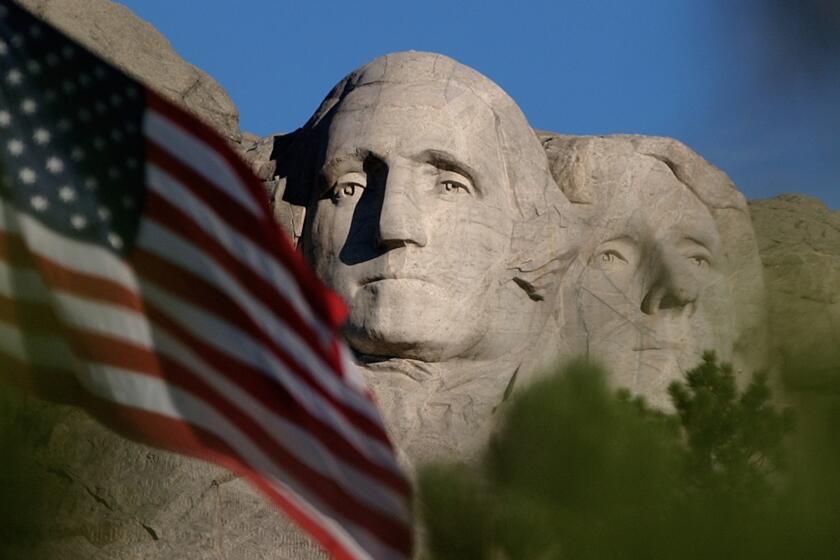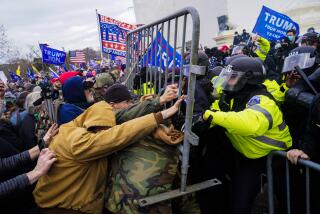Op-Ed: Could the racist past of Mt. Rushmore’s creator bring down the monument?
- Share via
Confederate President Jefferson Davis has been toppled from the most iconic street in Richmond, Va., and his neighbor, rebel Gen. Robert E. Lee, may soon follow. A U.S. vice president and ardent slavery defender, John C. Calhoun, was plucked from his 115-foot perch in the center of Charleston, S.C. And President Theodore Roosevelt may soon disappear from the steps of New York City’s American Museum of Natural History.
Is there any monument in the United States that’s too big to fail a racial history test? A piece of public art with a connection to our checkered past that is too important, too monumental, to be removed from the face of America? Could Mt. Rushmore be that ultimate test?
We could soon find out. President Trump is planning to spend Friday watching the fireworks — and, no doubt, lobbing a few verbal ones — in the Black Hills of South Dakota. His visit will likely remind Americans that Rushmore’s presidential problem is as plain as the nose on George Washington’s face. Washington (owner of 123 slaves) and Thomas Jefferson (who enslaved more than 600 humans throughout his life) are only the beginning. Roosevelt’s mixed legacy — the Smithsonian flat-out calls him a “racist” even while noting he invited Booker T. Washington to dine at the White House — adds another pockmark on those faces of history.
President Trump’s plan to kick off the Fourth of July with a showy display at Mt. Rushmore is drawing sharp criticism from Native Americans.
Yet Mt. Rushmore’s hold on history is threatened by elements that go beyond the question of whether its subjects merit memorializing. Even before the first chip of rock had been hewn from the mountainside, Native Americans objected that the carving was on land they considered both sacred and stolen. Less controversial at the time was the past of Rushmore’s creator, an enigmatic Danish American named Gutzon Borglum. By the early 1900s Borglum was a celebrated sculptor, especially of Lincoln statues. He was also an avowed racist.
In fact, he was a card-carrying member of the Ku Klux Klan. His involvement with the Klan started in 1915, when he contrived to win the commission to build a monument to the Confederacy at Stone Mountain, Ga. The project was sponsored by the Daughters of the Confederacy, whose legacy of monuments to doomed Southern valor is currently the target of demonstrations across the country. Fired up by the infamous film “Birth of A Nation,” Klansmen had paraded to the top of Stone Mountain to stage a rally and burn a cross on Thanksgiving 1915.
Borglum quickly saw the Klan as a source of financial and moral support for his massive project. By 1923, Borglum was named to the Kloncilium, the highest national council of the Klan, and in 1924 he tried to engineer a presidential campaign for his favorite imperial wizard.
Although he mastered the art of mass-scale sculpting on the Stone Mountain cliffside, the moody, imperious Borglum was finally fired from the project after a tumultuous decade, and his work was ultimately blasted out of the stone. Borglum soon moved on to Mt. Rushmore, but he always hoped to return to complete Stone Mountain. When Henry Augustus Lukeman was commissioned to replace him at Stone Mountain, Borglum was irate. “Every able man in America refused it, and thank God, every Christian,” the Smithsonian reported Borglum saying at the time. “They got a Jew.”
Yes, Borglum wasn’t just a racist. He was also an anti-Semite. In an essay he wrote in the 1920s called “The Jewish Question,” he said, “Jews refuse to enter the mainstream of civilization, to become producing members of the world community. They do not share or create, but choose instead to clannishly hold onto their old ways and with mere money buy and sell the efforts of others.”
Remarkably, Borglum sent a draft of his essay to Isidore Singer, a friend who was the editor of the Jewish Encyclopedia, to ask his opinion. Singer replied, with good humor: “Dear friend Gutzon, reading what you write someone would think you were an anti-Semite, when in reality you are a philo-Semite.” Borglum’s response: “If you were not a bigger man than you are a Jew, I would throw bricks at you.”
And now, perhaps, comes America’s turn to throw bricks at Borglum and his greatest creation. While some of the statues banished in recent months have arguably been of dubious artistic merit, Mt. Rushmore is an undisputed artistic and engineering triumph. It also presents us with perhaps the ultimate challenge to public art — or any art.
What should be done with an accomplishment of global significance that features problematic men carved in a problematic location by a problematic sculptor? Perhaps Rushmore’s massive scale will prove to be a blessing during this tumultuous time. Too large to be pulled down overnight, it may force us to have a substantive public conversation on how and whom we choose to remember in American history.
Timothy D. Dwyer is researching his next book, a history of Mt. Rushmore and its creator, Gutzon Borglum.
More to Read
A cure for the common opinion
Get thought-provoking perspectives with our weekly newsletter.
You may occasionally receive promotional content from the Los Angeles Times.











